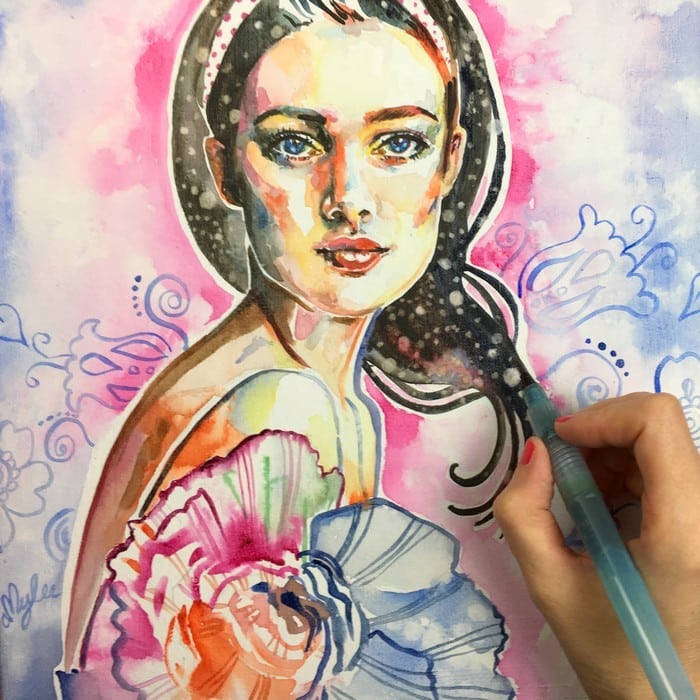With watercolour painting, I particularly like it when the pigment penetrates the surface, and when the water plays with the transparency and creates light effects, but, paper is not always my favourite medium. How can I achieve painting on canvas with watercolour?
Friends of the traditional watercolour method will certainly be saying: “What? How can you think of doing that? In watercolour, it is the paper that is the most important! On canvas, the result will be ugly! What a wacky idea? “
“And why not?” I want to answer. “Let’s be crazy, let’s be artists!”
Semi-absorbent Primer: Sennelier Gesso
I recently tested the semi-absorbent Sennelier Gesso. It deserves to be investigated because it is a nice step forward in the technique of watercolour on canvas.
Unlike an ordinary gesso (impervious and too slippery), the semi-absorbent gesso has the ability to make the grain of a fabric finer and increase the absorption of the surface (as a sheet of watercolour paper can be).
After drying, the gesso forms a porous surface that improves the penetration and diffusion of colour. You can also use it to create added textures with a palette knife. The reliefs capture the colour in the hollows and provide an interesting 3D effect to different details of the composition. Unthinkable on paper!
1/ What are its characteristics?
- 500ml jar
- Easy application and +/- quick drying depending on thickness
- Ready to use (or can be tinted with acrylic paint)
- The white texture looks a bit like whipped cream
- Matt appearance after drying
- Possible techniques: acrylic, oil, watercolour, tempera, gouache
- Clean with soap and water
.
2/ How to use it?
– THE MATERIAL:
- 1 jar of Sennelier Semi-Absorbent Acrylic Gesso
- 1 wide brush (a spalter) or a palette knife
- 1 stretched canvas
- Sheets of sand paper (OPTIONAL)
- Materials for watercolour painting, water + cleaning roll paper
-
NOTE: Most of these products are currently available at GreatArt Online and can be ordered to collect from their art supply shop in London Shoreditch or delivered to your home.

– THE RECIPE:
- Remove the wrapping film from the canvas if it has one.
- Using a palette knife or brush, cover the canvas with 2 or 3 layers of semi-absorbent gesso. In this demonstration, I apply the gesso without making any relief.
- Leave each layer to dry before applying the next one.
NOTE : Lightly sand the final layer if you want to obtain a surface with a less visible grain.
.
3/ What are my observations?
- The smell of fresh gesso is a little like that of ammonia (small negative point). Do not worry, it disappears as it dries.
- Dry gesso on canvas has a touch slightly similar to that of paper.
- For the preparatory sketch, soft graphite pencils (8B or 6B) mark this gesso better than hard graphite pencils HB or H.
- Watercolour dries much more slowly on the semi-absorbent gesso than on the paper.
- Leaving white areas is super easy and you can even wash some details if necessary to correct (the canvas does not tear).
- Multiple colours can be applied in one place without altering the surface.
- The semi-absorbent gesso can be used in all watercolour techniques (on dry or wet surfaces).
- A watercolour fixative (after the work is complete) can be applied for better colour retention over time.
- Watercolour on canvas makes it easier to paint outdoors.
Demonstration in video:
Are you interested in relief? The video is very useful then.
Vous êtes actuellement en train de consulter le contenu d’un espace réservé de YouTube. Pour accéder au contenu réel, cliquez sur le bouton ci-dessous. Veuillez noter que ce faisant, des données seront partagées avec des providers tiers.
My conclusion:
I loved painting with watercolour on this semi-absorbent gesso. As on paper, I quickly found I could achieve all my little habits: the random effects caused by the absorption of the water and the drying of the colours, the reserve of the whites, the soft gradients, the halos, the cloudy effects, the washes, working on dry or wet, the calligraphic lines. There is just the melting of colours that I find less attractive. This primer really accepts all fantasies and especially the most risky repentirs (without any holes as with paper).
The semi-asborbent gesso will satisfy beginner painters, students or simply artists who enjoy working on canvas or using watercolour differently.
DISCLAIMER : Cet article est une collaboration sponsorisée. Je fais partie des artistes référents qui utilisent le matériel proposé par Le Géant Des Beaux-Arts – France et GreatArt – United Kingdom. Vous venez de lire mon article issu de cette collaboration. Au risque de me répéter, sachez que j’apprécie les marques distribuées par ce partenaire depuis des années, et que je suis convaincue de la qualité du matériel destiné aux artistes et aux personnes créatives. Même si cela paraît logique, je précise que je suis LIBRE sur la thématique et le choix des produits mis en avant, LIBRE sur le contenu, LIBRE de donner mon VÉRITABLE avis, et c’est également pour cette raison que ce partenariat est important car je peux donner libre cours à mon imagination et ainsi proposer régulièrement du contenu frais et de qualité.









